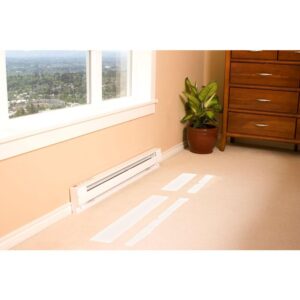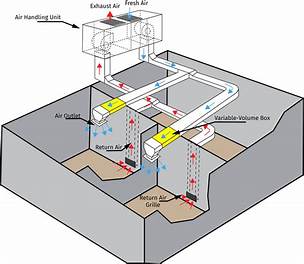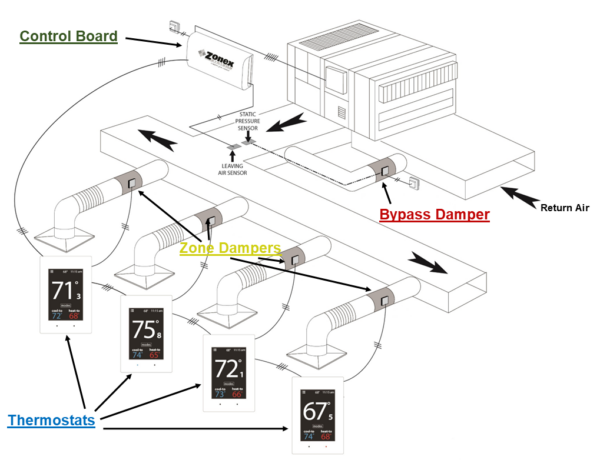
Unless you are able to add to an existing hot water baseboard or in floor heating system, you’ll need to read the following. Either way, depending on your climate and needs, IRC Building Code requires that you add to your existing heating system and or install a new separate heating system to achieve basement supplemental heating but this might not be in the budget . Typically, most basements use forced air systems and air ducts using standard six inch round ducts to each area that attach to a 4X10 vent opening are needed to be installed. These run as far to perimeter walls as possible to keep heating cooler air coming from the exterior walls and or windows and doors if any.
All of this will Depend on if your systems BTU’s are maxed out or not (consult with a HVAC expert), most are not and if not, a quick formula is one heat duct per 175 square feet but codes vary from state to state. You may compare with your furnace BTU rating and measure your cubic meters before converting it for use with your additional space but again, a HVAC expert can tell you this faster. You’ll also need an equal size cold air return. If your cubic meters in the existing structure is maxed, there’s alternatives since there’s an issue even though you do this to code adding to the existing furnace; since the heat blows in the basement only when the main floor thermostat comes on, it turns off too when the main floor thermostat is satisfied leaving the basement 6-8 degrees colder in the winter months normally. Of course a new 2nd forced air or hot water heat unit as a separate zone solves this issue, it’s more expensive and not necessary. So if you want to save money, read on. FYI: I wrote more on calculating BTU’s at my post; Basement Finishing 102

So there are many options for what I call basement supplemental heating and some I recommend and some I don’t. Many clients like the thought of in floor radiant heating. The liquid type requires a boiler system and or hot water unit but this adds to the cost big time as well as it reduces the ceiling height. There’s an electric type using a precut Mylar mesh type that can go under most finish flooring products but my concern with these is that once it shorts out, you have to remove the finished flooring to fix it. They do have a system add-on known as “Zone Damper System” in which are zone controlled in existing forced air units by way of electric dampers opening and closing independently controlling each zone providing heating and cooling without upgrading to a larger BTU and such but again, this cost goes up allot to.

So my favorite low cost supplemental heating suggestion is having me add electric baseboard units (featured image) with independent thermostats in the area’s needing heat. This can be put in for about $300-$700 per needed area and will satisfy code requirements with or without the forced air blowing down there. This is provided you use the rule of thumb if using electric baseboard heat unit formula of 10 watts per square foot. Example; a 150 square foot area would need a 1500 watt baseboard heater. If using the existing heat runs off the existing forced air system, you can relax using a bit less wattage per square foot as this system will be there to just help bring the temperature requested up to normal desire as the main floor. The featured post image above is a sample of a 72 inch unit found at this link for about 50 bucks; 1,500-Watt 240-Volt Electric Baseboard Heater
I normally don’t show the vents and cold air return that code requires on any designs I create since those HVAC guys end up putting them where they want anyway. Code requires a cold air return be added as well. Additionally if you want to be more comfortable down there have me show electric baseboard units tied to the thermostat to keep it automatic. Remember; once the main floor thermostat turns the furnace off, so does the heat in the basement go off thus leaving it 6-8 degrees colder all the time. So this basement supplemental heating should be used even to add to the required heat runs and cold air return. Now keep in mind when using a fireplace with blower and thermostat along with any other basement supplemental heating including electric fireplaces, HVAC ducts are not required provided you are using an adequate source of heat. But even with a fireplace, rooms behind other closed doors such as bedrooms, offices and so on will cool down and this is where the supplemental heating electric baseboards can take over. Plus, if you are not using these other rooms, you just turn off the independent thermostat in that room thus saving more money.
Also, leaving the HVAC out of the bids with the basement supplemental heating in place along with or without a fireplace is going to provide the best source of heat for the entire house too thus keeping the furnace from coming on so often to heat the main floor. I understand gas may or may not be about the same cost as electric these days. Keeping the heat under the fry pan is always best as heat does rise and it only gets better if you do the pellet stove with an auto feeder, blower and thermostat. Most of my clients tell me they are saving 30-40% using these. Yes, you have to fill the auto feeder once a week maybe but you’re going to replenish the cost over time and then put money back in your pocket. They do cost more than fireplace units typically but still, there’s a payback period that will be paying for the basement build out too over time.
Click the following link to return to Basement Finishing 102 by John Browning
Don’t miss reading my blog Basement Finishing 101 if you still don’t have a design and look for Basement Finishing 103 regarding building your basement and another similar topic How To Finish A basement Yourself. Thank you and please Contact Me no matter what your question might be.